A team from Millsaps College studied this phenomenon near Vicksburg, Mississippi (C.D. Caplenor et al, Forests of West Central Mississippi as Affected by Loess" in Loess Investigations in Mississippi, Bulletin 111. Mississippi Geological, Economic and Topographical Survey. Jackson, MS. 1968) by documenting which tree species dominated sites in "upland non-loess," "thin loess," and "thick loess." Here is a simplified and generalized review of their results, showing the five dominate tree species in terms of "percent total density" in each category:
This list is fascinating. For one thing, it's striking that Sweetgum, with its star-shaped leaves and burred, brown fruits, is so dominant on deep loess, but doesn't even appear among the thin-loess list's top five. Similarly, in no-loess territory, pines comprise nearly half the tree population in terms of density, but don't even appear in the other top-five lists. The profound effects of loess on biological communities could hardly be more convincingly illustrated.
It is impossible to overstate the importance of trees to our loess-zone ancestors. When the early settlers passed through an area and saw which trees grew there, they immediately knew what the local soils were like, and they could imagine all sorts of industries possible if they stayed there. In the same way, Indians knew what kind of wildlife to expect, and what kinds of nuts, berries, and other fruits they could gather.
To gain a feeling for what having such insights might have been like, let's take a quick look at some of the main species appearing in the above "thick loess" and "thin loess" lists:
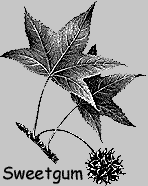
SWEETGUM
Sweetgum, in Mississippi often known as Redgum, is easy to identify because its leaves are more or less star-shaped, with five lobes, and the trees produce strange, soft-spiny, spherical, Hercules-club-type fruits. In the fall Sweetgum leaves turn red and yellow, often being the most colorful component of our autumn landscape.
In most of the Loess Hills Sweetgums are even more conspicuous than their 15.2% density rating implies, for when a forest is disturbed, as by logging, Sweetgum seedlings tend to be the first to reestablish themselves. That's because each Sweetgum fruit, while still hanging on the tree, releases into the wind dozens of quarter-inch-long, winged seeds, which autumn winds can carry for long distances. In ecological terms, Sweetgums are part of "nature's first-aid crew," in the sense that they quickly enter damaged forests, produce quick growth, stabilize soil, and eventually yield to other tree species.
Sweetgum wood has been sold under the trade name of "satin-walnut," and has been used in the production of veneer, interior trim, and furniture.
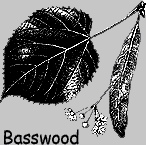
BASSWOOD
In much of the Loess Hill zone, Basswood is absent. However, were it does occur, in the zone's southern half, it can be fairly common. Benjamine Wails, the first serious naturalist to publish notes on the loess zone, noted in 1854 that settlers were felling large Basswoods, stripping away the trees' fibrous inner bark, and using the fibers for tying together tobacco leaves. In fact, the pioneers must have used Basswood fibers for many purposes. Jute, in the past much grown for its fibers, is another member of the Basswood Family of plants.
Today honey connoisseurs know that honeybees taking their nectar from fragrant Basswood blossoms produce an excellent honey. These same flowers can be boiled in a pot to produce a rich, sweet tea. The tree's broad, soft, heart-shaped leaves, whose margins are serrated with many small teeth, are so soft that in the spring they can be eaten directly off the tree. This is not necessarily haut cuisine, but Indians and the pioneers must have appreciated the leaves as an emergency food.
Basswood wood is excellent and has been used for many purposes, including the making of plywood, interior trim, and cheap furniture.
In contrast to Sweetgums, Basswood does not vigorously reestablish itself once the forest ecosystem has been disrupted. Apparently the Millsaps team investigated relatively undisturbed forest sites. Thus in most of the loess zone Basswood isn't as conspicuous as the list suggests.

BITTERNUT HICKORY
Several hickories occur in the loess zone and often the various species are hard to distinguish from one another. However, Bitternut Hickories are easy to differentiate because their buds are covered with tiny, sulfur-yellow scales. Other hickories lack the yellow buds.
As the name implies, this species's nuts are bitter to humans, though wildlife hardly seems to notice. Predictably, squirrels and chipmunks are its main fans. One feature enhancing the Bitternut's attraction for wildlife is that both its nuts' husks and shells are thinner than in most other species, causing the oily nut to be more easily available to wildlife.
Hickory wood is famed for its strength and durability. However, the Bitternut's wood is among the least desirable of the group. Nonetheless, it is acceptable when the preferred hickory species are not available, and also makes an excellent firewood.
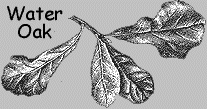
WATER OAK
Distribution maps in the Golden Field Guide Trees of North America show about twenty-two species of oak occurring in some or all of our Loess Hill region. The Water Oak can be distinguished from all the others by its small, black acorns, and by its leaves, which are small (usually no larger than 4" long by 2" wide), variously club-shaped (broad at their tips and narrowing to their bases), and tending to remain on the trees, more or less green, through most of the winter.
All oaks are profoundly important to wildlife. Their acorns are prime food sources not only for the various squirrel species and Chipmunks, but also Raccoons, Whitetail Deer, Wild Boar, and even several species of birds, particularly Turkeys, Wood Ducks, and Blue Jays.
Water Oak wood is not as highly regarded for woodwork as that of most other oak species, but loggers often mix it in with the preferred species. It's a good fuel wood. Because Water Oaks grow rapidly during their first few years of development, are easy to propagate, and are pleasing in form, they are favorite street and lawn trees throughout the South.
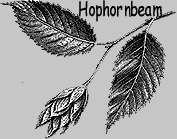
HOPHORNBEAM
Of all the listed trees, despite its obvious importance in loess zone forests, Hophornbeam may be the species name least recognizable to average nature lovers. One reason may be that Hophornbeams are often misidentified as elms. Their leaves are fairly similar, but the bark of Hophornbeam is very distinctive on older trees, being ashy gray, and covered with narrow scales free at the ends so that the trunk has a somewhat fleecy or shaggy appearance. The best distinction, however, is the fruits, which form in two-inch-long, cone-like clusters, and are composed of several green, papery, inflated, bladder-like sacs surrounding individual small seeds. The clusters look like fruits of the Hops vine, and thus the name.
Though Hophornbeams grow throughout most of eastern North America, they are usually small trees seldom more than about twenty-five feet high. In our loess zone, however, the species seems to be most at home, for here it grows fifty or more feet high.
Hophornbeam wood is very durable. It's used as fence posts because it doesn't decay as easily as other woods, and because of its hardness has been used for tool handles and even mallets.
BEECH
Beech is another tree the Millsaps team found to be more common in their apparently less-disturbed study site than in average more-disturbed loess forests. Beech prefer relatively cool, shady, moist locations. When a loess-zone forest is logged, opening the forest to sun and wind, Sweetgums may quickly grow there, but Beech may not return for many decades. At the author's home just south of Natchez there are no Beech at all in the forests, which have been logged several times during the last century.
Beech trees are easy to recognize with their smooth, slate-gray bark. Their barks is so smooth that Beech is the favorite of all trees for people who like to carve their initials into bark. Beech buds are also singular, being exceedingly long and narrow.
Beechnuts, in older, moister forests where Beech are more common than oaks, are just as important as the oaks' acorns, and are important to the same species. Being smaller than acorns, beechnuts are also eaten in vast quantities by smaller species, such as Tufted Titmice and Red-bellied Woodpeckers, and even rodents. White-footed Mice may store a quart or more of seeds in any convenient rotted-out log or hole beneath a rock.
Beech wood has long been sought for many purposes. With birch and maple it's been used in the production of charcoal, wood alcohol, and acetate of lime. From its wood is made veneers, flooring, furniture, spools, crates, turned articles, and many other items. It is a superior burning wood when dry.
BLACK TUPELO
Black Tupelo, or Black Gum, is another species putting on a show in the fall, when its glossy leaves turn scarlet. This tree often goes unidentified because its leaves are rather plain, having no teeth or lobes.
When ripe in the fall, the fruits are like small, dark blue, rather bitter, large-pitted cherries. People find no use for the fruits but birds can often been seen gorging themselves. Among the most frequent are Wood Ducks, Turkeys, Robins, Flickers, Pileated Woodpeckers, Mockingbirds, Brown Thrashers, and the various thrushes. Foxes relish the fruit, while Whitetail Deer eat the twigs and foliage.
The wood is good, medium-grade material, and has been used in the manufacture of plywood, crossties, handles, and made into paper pulp.
BLACK OAK
Of the twenty-two-odd oak species appearing in the loess zone, Black Oak can be distinguished by its leaves, which bear five to seven toothed, bristle-tipped lobes, and the leaves' lower surface are velvety hairy when young. Older leaves on the lower surface bear tufts of hairs in the axils between the midrib and secondary veins. If you ever have a magnifying glass handy when you're near a Black Oak leaf, look at those hairs. They are "stellate" -- like minute stars with rays radiating from them.
The Black Oak's acorns are of the same importance to wildlife as the Water Oak's, which is considerable.
Black Oak bark contains not only a yellow dye known commercially as quercitron, but also a tremendous amount of tannic acid, which in the past was much used for tanning leather. Tannic acid is extremely astringent, or "puckery," and as such has long been used in folk medicine. As a decoction of one ounce of bark in a quart of water, boiled down to a pint and taken in wine-glass-size doses, it was used to control some forms of diarrhea. In stronger doses it was used to control internal hemorrhaging, and bleeding from flesh cuts and bleeding gums. Its puckeriness also causes hemorrhoids to withdraw.
Black Oak wood is excellent, used for flooring, furniture, interior trim, cabinetry, and a plethora of other services.
MOCKERNUT HICKORY
From its name you might think that Mockernuts are "mock," or "fake" nuts, but that's not so; the nuts are sweet and of a good size. However, the husk is thick and the shell is very hard, so during "hickory-nut season" our zone's Indians and pioneers surely appreciated Mockernuts, but for their main harvests probably sought out easier-to-crack Shagbark Hickory. This species also occurs in the loess zone, but is most common in the nearby swampy bottomlands. Hickory nuts can be stored for months. Since their "meat" is so oily, it makes a wonderful high-calorie food. The Indians made cakes, soup, butter, and hair-oil from hickory nuts.
*****
Many tree species other than the above nine are common in the loess zone. The Millsaps College investigators identified about forty species just in their study area. In fact, some common species not making the list are among the most interesting.
There's Sassafras, whose boiled roots produce the famous sassafras tea used by our ancestors as a "spring tonic" that "thins the blood." Many of our forefathers also made a beer by boiling Sassafras twigs in water, adding molasses, and allowing to ferment.
Red Mulberry produces berries highly honored by the Indians and pioneers, plus the inner bark is so fibrous that string can be made from it, and rough clothing can be made from the string.
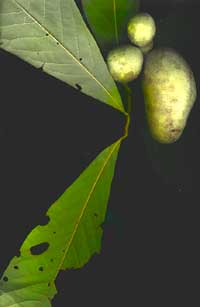 Then there's Pawpaw,
a small tree that forms dense colonies in the shaded understory, and for a fleeting moment
during the summer produces the heavenly musky-sweet fruit seen at the right. The larger
pawpaw in the picture is about 3.5 inches long (9 cm). The fruit's pale orange flesh when
mature is soft like over-ripe cantaloupe. To the Indians this must have been like pudding
growing on a tree!
Then there's Pawpaw,
a small tree that forms dense colonies in the shaded understory, and for a fleeting moment
during the summer produces the heavenly musky-sweet fruit seen at the right. The larger
pawpaw in the picture is about 3.5 inches long (9 cm). The fruit's pale orange flesh when
mature is soft like over-ripe cantaloupe. To the Indians this must have been like pudding
growing on a tree!
Spring in the zone is announced by two trees so beautiful that they have been introduced into Europe and Asia as ornamentals: our Redbud and Flowering Dogwood.
There's also the Black Walnut with its rich, oily nut, and the Hornbeam, often called Ironwood because of its hard, heavy wood. In the winter the Holly displays lustrous, evergreen leaves and scarlet fruits that splash the forest with color, and if you ever grab the prodigiously spiny stem of the Devils-Walkingstick you'll never forget it. In the southern part of the zone there's the Hercules-club, also called the Toothache-tree, because the bark and leaves contain nerve-deadening analgesics that numb certain pains. The slaves honored this plant for it helped them deal with their arthritis and toothaches.
On and on we can go, for the forests of our Loess Hills are nothing less than tree museums.